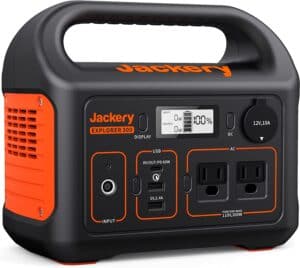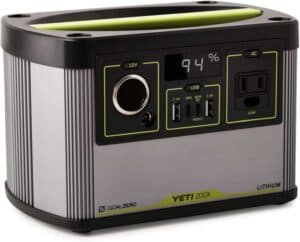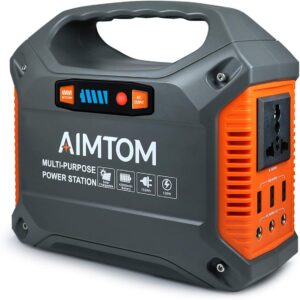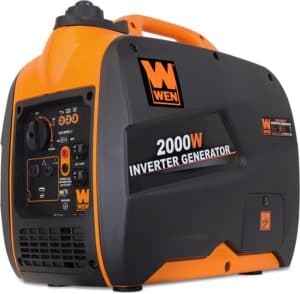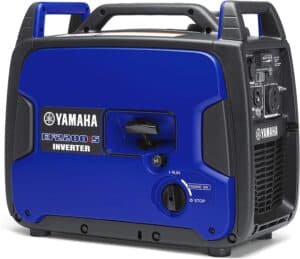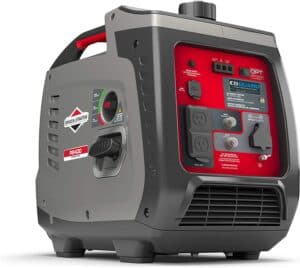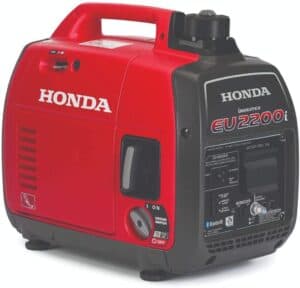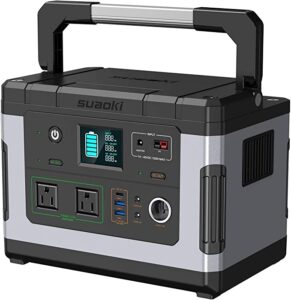A portable generator is the solution to all your power needs away from home. In addition to being a great power source for outdoor recreation, a portable generator can also be a lifesaver for unforeseen circumstances and emergency situations that could leave your home without power for days at a time.
By definition, a portable generator is “the combination of an electrical generator and an engine mounted together to form a single piece of equipment.” (1) This single piece of equipment is essential if your family’s camping needs depend on a reliable power source, or if you live in any area where a natural disaster could leave you without power for an extended period.
It can, however, be difficult to tell the difference between the many portable generators on the market today. So our list of the 10 Best Portable Generators will help you narrow things down by providing key specifications on the industry’s leading models. Also, be sure to read through our Buyer’s Guide for more information about choosing a portable generator that’s right for you.
1. Jackery Portable Power Station
The Jackery Portable Power Station Explorer 300 is a great choice for a solid portable power station. It can be charged to 89% capacity in just 2 hours. You can charge it at home, in your car, or with solar panels. It features a 293Wh lithium,-ion battery pack which provides constant power. This power station weighs just 7.1 lbs making it easy to move or take with you.
It comes loaded with power ports including; 2 AC outlet, 1 PD 60W USB-C port (input/output supported) , 1 fast charge 3.0 port, 1 USB-A port and 1 DC car port, the power station can recharge itself and charge (up to) 6 devices at the same time. This is a great option for emergency preparedness, camping, or other uses.
2. Goal Zero Yeti 150
\
Designed and engineered by power station experts, the Goal Zero Yeti 150 is capable of powering up to five devices at once. It’s great for charging many types of devices, including cell phones, tablets, cameras, and other small devices.
This portable generator contains a 168Wh lead-acid battery and a continuous 80-watt, 160-watt, surge modified-sine wave inverter. It offers 2.1A USB ports and 120-watt 12V ports and is rechargeable via AC, 12V, or Goal Zero solar panels, which are sold separately.
3. Aimtom Portable Generator
A great portable generator for both camping and emergency situations, the Aimtom can charge laptops, fans, Christmas lights, phones, GPS, cameras, RC helicopters, and so much more. When compared to similar styles of generators, the Aimtom provides a larger total power capacity of 42000mAh.
This portable generator offers a variety of outlets, including a 110V dual AC outlet, three 12V DC ports, and three 5V USB ports. It also takes 7-8 hours to recharge via wall outlet or car 12V adapter and includes a bright LED flashlight that will last up to 125 hours on a single charge.
4. Wen 56200i
This is the perfect portable generator for anyone that wants a power source that doesn’t make any excessive noise. According to the US Department of Health and Human Science, this generator’s extremely quiet operation is comparable to the sound of a normal conversation. This makes it perfect for campgrounds, construction sites, tailgates, and power outages.
This unit’s 4-stroke OHV engine produces 2000 surge watts and 1600 rated watts. This engine is both EPA III and CARB compliant, so it produces extremely clean power to safely operate and prevent damage to sensitive electronics. Lastly, this generator can power four devices at once, with two three-prong 120V receptacles, one 12V DC receptacle, and one 5V USB port.
5. Yamaha EF2000iS
The CARB-compliant Yamaha EF2000iS stands out from its competitors because of its super-quiet muffler with a USFS-approved spark arrestor and a Smart Throttle. This spark arrestor means that this generator produces just 51.5 dBA at ¼ load.
The Smart Throttle varies the unit’s engine speed based on load, which simultaneously improves fuel economy and reduces noise. This portable generator is an inverter system that also includes a Pulse Width Modulation (PWM) control.
6. Wen 56180
This EPA III and CARB compliant generator can be operated in all 50 states and provides 3800 surge watts and 3400 running watts. This makes it a great option for times of emergency as well as camping in national parks and forests.
It is approved for camping use in national parks and forests because of its low-oil shutdown that safeguards the 4-stroke OHV engine from damage and a spark arrestor that is required in such locations. The Wen 56380 will run at half load for 8.5 hours and consume just 1.1 gallons of gasoline.
7. Briggs & Stratton PowerSmart
With a fuel tank capacity of 1.5 gallons and a run time up to 10 hours at ¼ load, the PowerSmart series from Briggs and Stratton is safe for sensitive electronics and offers exceptional portability for car camping or other outdoor recreation pursuits.
This portable generator produces 3000 starting watts and 2600 running watts, which equates to roughly 21.7 running amps. It also includes an automatic idle control, low-oil shutdown, and a StatStation LCD display that shows the amount of power being used, total unit hours, and maintenance reminders, such as oil, air filter, and spark plug changes.
8. Honda EU2000i
This beast of a portable generator is capable of providing simultaneous power to TV/DVD, satellite, fridge, coffee pot, and more. It’s a great all-around generator for camping purposes as well as to have on hand for an emergency in your home.
The Honda EU2000i is super quiet, easy to carry, and extremely fuel-efficient. It can run up to 8.1 hours on just a single gallon of gasoline. Finally, this portable generator produces 2000 running watts or 120V of usable power.
9. SUAOKI G500
The compact G500 from SUAOKI is the perfect portable generator for keeping all of your small electronics charged in camp, or at home during a power outage. It provides a 500Wh power capacity that can charge a regular smartphone or laptop, as well as small appliances such as a mini fridge, speaker, or projector.
This portable generator is equipped with three quick charge USB ports. Two of these are USB-A ports and one is a USB-C port. It also includes DC ports that support 12V/3A output and a 12V/10A car port to power in-car devices. Finally, this lithium portable generator can be recharged via AC wall outlet, 12C cigarette lighter, or solar panel, which is sold separately.
—
Buyer’s Guide
The operating principle behind today’s portable generators was first introduced in 1831 by an English scientist named Michael Faraday (2). Faraday’s efforts led to electricity becoming available in many of today’s technologies.
When it comes to selecting from the many portable generators out there today, there are a few important characteristics to consider. To simplify things, this Buyer’s Guide will focus on power needs, portability, runtime, and outlets.
Power Needs
The first, and most obvious, consideration when selecting a portable generator is just how much power you’ll need. This requires thinking about how many devices or appliances you want to run off this one generator. It also requires you to know the wattage needed by each device as well as how much total wattage all devices and appliances will need.
Power needs will vary greatly depending on a number of factors. If you want a generator as a backup for your whole house, in the case of a power outage, you’ll need more wattage to power large appliances like a refrigerator and furnace.
But if you only want a generator that’s capable of charging everyone’s phones on your next car camping trip, your total wattage needs will be considerably less. It can often be helpful to make a list of all the devices you’ll want to power and then determine how much power it takes to start and run all of those devices.
Portability
Another important consideration is how easily you’ll be able to move around your generator. Of course, if your intention is to house the generator in your garage for emergency situations only, then portability is less of a priority.
If you plan on using your new generator for camping or other outdoor recreation pursuits, however, ease of transportation becomes much more important. Consider whether the generators you’re thinking of buying have wheels, as well as looking at how much they weigh, both empty and when they’re full of gasoline.
Runtime
Runtime is also important because you won’t always be able to accurately predict just how long you’ll need to rely on your generator as a power source. In most camping scenarios, it’ll be easier to regulate the amount of time you’ll need a generator. In this case, it might be limited to evening use for charging phones and running lights around the campground.
However, if you need a portable generator as a household backup or as a reliable power source on a construction site, you’ll likely be running it for hours at a time. In these scenarios, we recommend finding a portable generator that provides at least 10 hours of runtime.
Outlets
The final consideration when selecting a portable generator is the number and type of outlets each generator provides. The amount and specific type of outlets you’ll need will also depend on the devices and appliances you intend to power at once.
Unfortunately, not all devices and appliances use the same outlet types. This can become a critical consideration in the event of a home emergency. Make sure that the portable generator you select has enough outlets to supply power to all your essential appliances in the case of an emergency.
Frequently Asked Questions
Because not all portable generators are created equal, there is a lot to learn about using, storing, and maintaining them. Our Frequently Asked Questions section will provide answers to some of the most common questions about portable generators in order to help you make the best selection possible.
How many watts does a generator need to power a house?
Most household appliances require between 3000 and 6500 watts. Homes with a smaller furnace and a city water connection can generally get by with a generator that provides between 3000 and 5000 watts. Homes with larger furnaces and a well pump, however, may require between 5000 and 6500 watts.
How many watts does it take to run a refrigerator on a generator?
Most appliances and devices need a certain starting wattage to power up and then less wattage to continue running. Common household refrigerators need around 2200 starting watts and then 700 running watts to continue operating efficiently.
Are there classifications of portable generators?
Generally, there are five common types of portable generator. They are solar/battery (great for camping and the least resource intensive), recreational inverter (great for RV enthusiasts and tailgaters), emergency (designed for emergencies but also worthy for camping or tailgating), semi-professional (popular amongst high-end homeowners and contractors), and professional (built for professionals that recognize that quality doesn’t come cheap).
What’s the best way to maintain a portable generator?
Because every model is different, the best techniques for maximizing the life of your portable generator will always be contained with the manufacturer’s operating, maintenance, and safety instructions.
Can you store a generator with gas in it?
While it’s not recommended, it is possible to store a gas-powered generator with a full fuel tank. However, most generators will require fuel stabilizer in order to do so safely. Fuel stabilizer prevents gum, varnish, rust, and corrosion from forming in a portable generator engine (3).
What’s the difference between rated watts and maximum (surge) watts?
Rated watts provide a measurement of the amount of power a portable generator can continuously produce. Maximum watts are the rating of power that a portable generator can produce for a short period of time. Maximum wattage is most need when starting a device or appliance (4).
What’s the difference between a standby generator and a portable generator?
When it comes to providing backup power for a home, portable generators are typically viewed as a temporary fix while standby generators are seen as more of a permanent solution. Portable generators need to be manually connected when needed, but also have the advantage of being used in situations other than only as a home backup power source.
Summary
Whichever generator you choose, it’s really important to become familiar with the best practices for generator safety (5). We hope that you’ve found the information in this article useful and we wish you the best of luck finding the portable generator that’s perfect for your needs.
